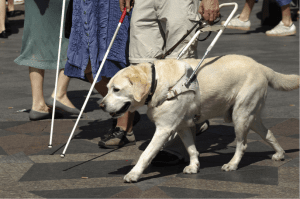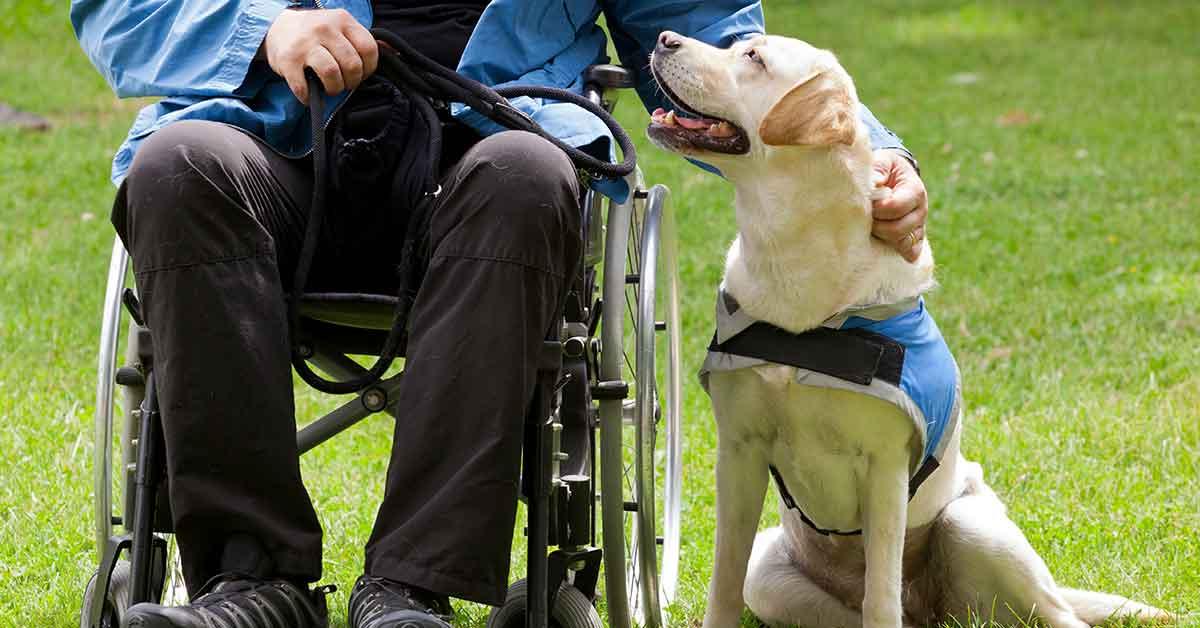Modern technology has aided in improving the daily lives of humans across the planet. However, despite all the advances of the modern age, there are still many situations which are encountered by those with disabilities on a regular basis which are difficult if not impossible for them to overcome on their own. Luckily, training techniques for animals have made it to a point where humans have been able to train animals to help people with disabilities who have otherwise been failed by modern advancements.
The most common type of service animal is a dog thanks to their intelligent, obedient nature and their strong connection to the human race. Service dogs are capable of assisting their human counterparts in vastly different tasks tailored to the specific needs of their handlers. A service dog can be life-changing for a person suffering from a disability. Let’s talk about the specifics of what a service dog is and what they’re capable of.
What is a Service Dog?
Service dogs are animals trained to perform specific tasks according to their handler’s needs. Service dogs assist people with a range of disabilities from physical impairments such as blindness and mobility issues to mental disabilities like post-traumatic stress disorder (PTSD) or obsessive-compulsive disorder (OCD).
Service dogs help their disabled handlers through tasks such as guiding them around obstacles while walking; alerting them to noises such as alarms, sirens, or oncoming traffic; retrieving water bottles, medication, or dropped objects; reminding the handler to take prescribed medications; and diffusing anxiety attacks.
If you or someone you know has a disability, a service dog may be a helpful course of treatment. It’s important to do research to make sure your disability is eligible for a service dog before applying.
The Americans with Disabilities Act (ADA) describes an “individual with a disability as a person who has a physical or mental impairment that substantially limits one or more major life activities, has a record of the impairment, or is regarded as having such an impairment.” This definition is somewhat loose and vague, but the main takeaway is that a person is considered to be disabled if their life is more difficult in some way when compared to the average person.
This means a person can be considered disabled for either physical or mental impairments. Physical disabilities are often much easier to diagnose and prove. Furthermore, physical disabilities tend to lead to more obvious solutions regarding tasks that service dogs would be trained to perform on behalf of the disabled handler.
Not every physical disability automatically qualifies an individual for a service animal, but physicians can assess the needs of each person on an individual basis and provide recommendations based on those factors. Here are some of the more common physical disabilities that can be aided through the use of service animals.
Eligible Physical Disabilities
The ADA defines physical disabilities as:
“Any physiological disorder or condition, cosmetic disfigurement, or anatomical loss affecting one or more of the following body systems: neurological, musculoskeletal, special sense organs, respiratory (including speech organs), cardiovascular, reproductive, digestive, genitourinary, hemic and lymphatic, skin, and endocrine.”
Physical disabilities that may qualify for service animals include but aren’t limited to:
- Blindness (partial and complete)
- Deafness (partial and complete)
- Paralysis
- Multiple Sclerosis
- Autism
- Epilepsy
- Osteoporosis
- Scoliosis
- Allergies
- Asthma
- Arthritis
- Seizures
Service animals can assist people with physical disabilities in a variety of ways depending on the specific nature of their handler’s disability.
Get a FREE Service Animal Training Consultation
How can a service dog help someone with a sensory disability?


 Whether a person is blind, deaf, or anywhere in between, a service dog can vastly improve their quality of life as well as their general safety. Service animals can assist their handlers with sensory issues by guiding them while walking around their home, helping them navigate through streets and buildings, or by alerting the handler to sounds such as a phone ringing, sirens sounding, knocking on a door, or an alarm clock going off.
Whether a person is blind, deaf, or anywhere in between, a service dog can vastly improve their quality of life as well as their general safety. Service animals can assist their handlers with sensory issues by guiding them while walking around their home, helping them navigate through streets and buildings, or by alerting the handler to sounds such as a phone ringing, sirens sounding, knocking on a door, or an alarm clock going off.
Many people who have impaired vision can lose a lot of their sense of security and independence. Daily tasks are much more difficult for those who cannot see what’s right in front of them. A “seeing-eye dog” can help their owners regain much of their lost independence by providing their handlers with guidance while they go about daily tasks such as grocery shopping or going out to a restaurant.
The same can be said for those who are deaf or hard of hearing. Service dogs can be specially trained to alert their handlers when there are sounds that require the attention of the handler. A knock on a door can easily go unnoticed and the sound of a car quickly whizzing by could be missed by a person who lacks the faculty of hearing and result in injury or even death. With the aid of a service animal, those who are hard of hearing can more safely navigate the world around them without having to worry about what they might not be noticing.
Service animals are capable of providing aid for people suffering from mobility impairments as well.
How can a service dog help someone with mobility issues?
Service dogs are able to provide help for handlers with mobility issues in many different ways such as pushing or pulling a wheelchair, providing stability during walking or standing, retrieving objects from the floor or from across the room, and completing tasks such as turning lights on and off and covering their handler with a blanket.
Many people who are wheelchair-bound may lack the ability to retrieve dropped objects. This can result in pain and humiliation for those who are already suffering. Having a service dog around to help them pick up their dropped keys can be an enormous boon for them. Being able to rely on a service animal instead of the kindness of strangers when a disabled person is in need can provide them with a much greater sense of independence and personal security.
Service animals can help their handlers in times of extreme need by performing various tasks as well.
How can a service dog help during an emergency?
First of all, service dogs can help prevent emergencies by reminding their handler to take prescribed medications or aiding them before the situation becomes dire. Service animals can be trained to sniff out allergens and alert their handlers before they ingest something that contains chemicals or substances which could cause potentially deadly reactions. Furthermore, service animals can help call 911, a doctor, or a family member in the case of an emergency such as an allergic reaction, asthma attack, or a seizure. Service animals can also provide aid to those in need by rolling over their handler and clearing the airways to prevent suffocation during a health emergency situation.
The tasks service animals are capable of accomplishing are quite astonishing. Service dogs can be trained to do many tasks that are specialized to the handler’s individual needs. In addition to service dogs being employed to help those with physical disabilities, they are also capable of being trained to aid individuals with mental disabilities.
Eligible Mental Disabilities
The ADA defines mental disabilities as “Any mental or psychological disorder, such as mental retardation, organic brain syndrome, emotional or mental illness, and specific learning disabilities.”
Eligible mental disabilities include but aren’t limited to:
- Bipolar Disorder
- Post Traumatic Stress Disorder
- Anxiety
- Depression
- Mood disorders
- Eating disorders
- Neurocognitive disorders
- Psychotic disorders
- Substance Abuse disorders
Service dogs can perform a range of tasks to help and support people with mental disabilities. The animals can be trained to distract and diffuse the handler from things such as depression, mood swings, self-harm, or a panic attack by rubbing, nuzzling, or licking their owner. They can also distract their handler by instigating play in ways such as bringing a ball or stick to the owner. Service dogs can also be trained to provide deep pressure therapy by lying on the chest of the handler to calm them during a panic attack.
Another task the dogs can perform is reminding the handler to take prescribed medications or calling a support person, therapist, or suicide hotline through programmed numbers on a dog-friendly phone. Service dogs can assist people with anxiety or post-traumatic stress disorder through crowd control by circling or guarding the handler to create a barrier or by guarding their backs. They can also enter a building to check the perimeters and reassure the handler that the area is safe.
Get a FREE Service Animal Training Consultation
Qualifying for a Service Dog
In order to qualify for a service dog, a person’s disability must first fall under the ADA definition of a mental or physical disability, but this is not necessarily enough on its own to qualify a person for a service animal. The person must also provide documentation from a medical professional that their disability could be improved or supported in some way by the service animal.
This means contacting a medical professional is most often the first step in acquiring a service animal. However, it’s important to understand that service animals aren’t an instant fix for all issues. Assessing the needs of the patient and the ways in which a service animal can aid them is paramount in the decision-making process of acquiring a service animal. A trained service animal can be quite expensive and comes with its own needs as well (food and water being the obvious ones).
Aside from the cost, learning to take advantage of the service animal is a process in and of itself. The person looking to make use of a service animal must learn how to properly interact with the animal and learn its signals and commands. Proving that a person’s disability can be improved by the presence of a service animal is something that can only be done by a trained professional. If the person is unable to provide a valid explanation of why a service animal is necessary, he or she is unlikely to be approved for one.
The ADA does not list every mental and physical disability that could be eligible as there are too many to list and there are many other factors that go into the decision to qualify a person for a service animal. If a person feels that his or her disability qualifies for a service animal and they meet all other requirements, he or she will need to go through the application process in order to determine if their specific case qualifies for a service animal. If you feel you may benefit from a service dog, talk to your therapist or physician today.
The possible benefits provided by a service animal are numerous. Highly trained service dogs can have a profound positive impact on the life of their handler, but make sure you perform your due diligence and consider the specific needs of the individual in question before seeking qualification for a service animal.
